
Silver’s Hill

Amicitia Crescimus


From: “Glimpses of Halifax and surroundings along the lines of the Dominion Atlantic and Central Railways: Beautifully illustrated with views of Halifax, Dartmouth, Weymouth, Digby and the Annapolis Valley”, 1900

From The Story of Dartmouth, by John P. Martin:
“This first picture was taken at the intersection of Prince Albert Road and Ochterloney Street on Saturday, September 14, 1907 (Below, as it looks in more modern times). The length of the shadow of the telephone pole indicates that the morning is not far advanced, yet there is almost a complete absence of pedestrian or vehicular traffic because by this time of day the market wagons and ice-carts have passed along to the ferry. An occasional delivery team from a downtown store might go by, otherwise, the quietude remained unbroken until noon hour when workmen came out of the Skate Factory for dinner.
The picket fence (hard to see, poor photo quality) at the left enclosed the vacant field of B. H. Eaton (later, Eaton Ave). The fenced-off level due north of the Starr Factory (middle ground) was the route of Bridge Street.
Within the last century, local truckmen and teamsters backed down to the pool at the right to fill water-puncheons or wash their carriages in fine weather.”
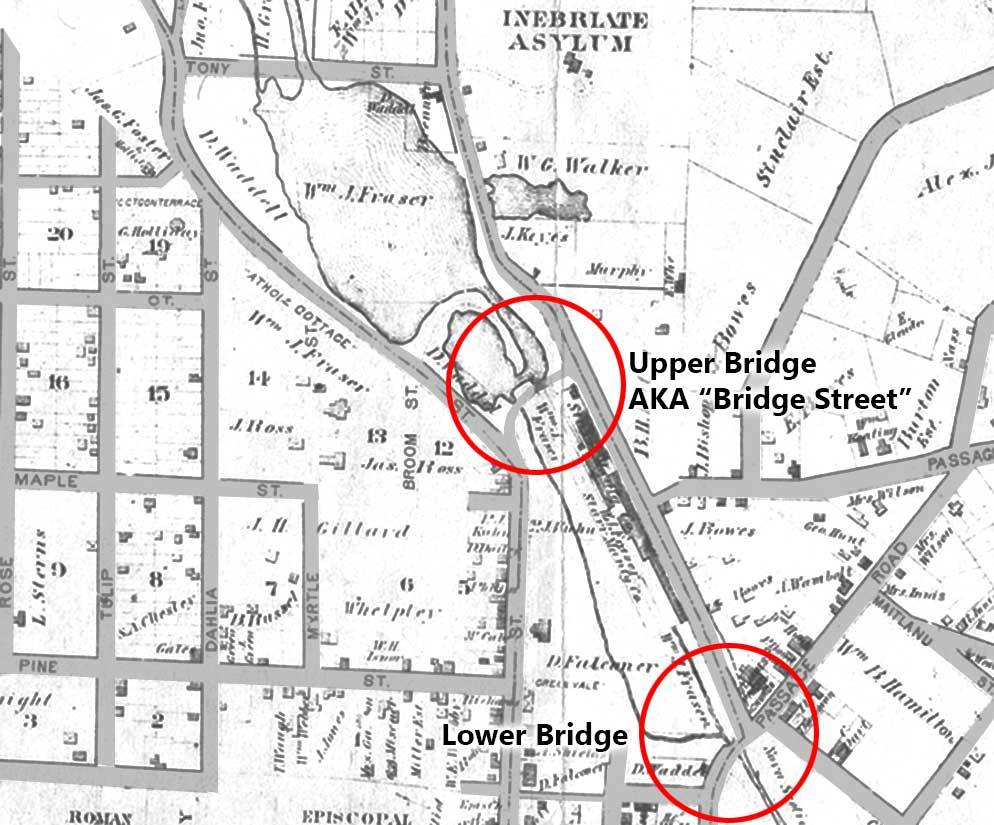
“Traffic to and from downtown Dartmouth crossed a small bridge in the stream opposite the present Memorial Park/ and another bridge at the head of the Starr Works where the road turned northerly to Prince Albert Road. All this was called Bridge Street.
The upper Canal bridge was built in 1886 and Ochterloney Street restored to its present shape. The route used for the previous 25 years over Bridge Street (because of the canal) was then abandoned.”

Remember that time Dartmouthians got so fed up with the substandard ferry service, they charted their own course, and organized a committee to start their own ferry service?
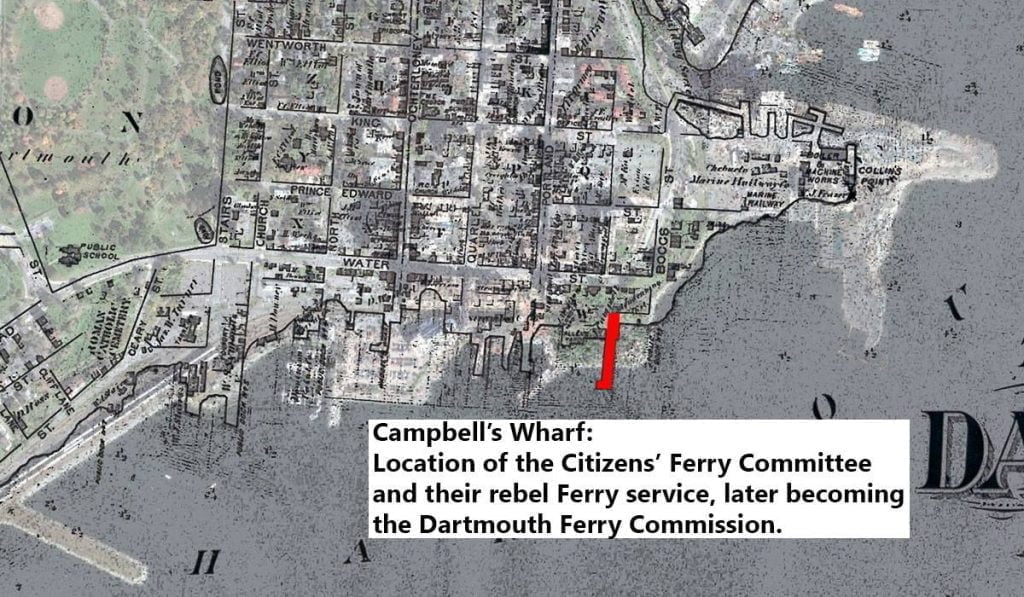
A ferry service that became so popular, the previous operators were abandoned in favor of the people’s service? This group even organized a ferry boat buying expedition to New York, in order to purchase a boat “formerly on the Pennsylvania Annex running from Brooklyn to Jersey City”.
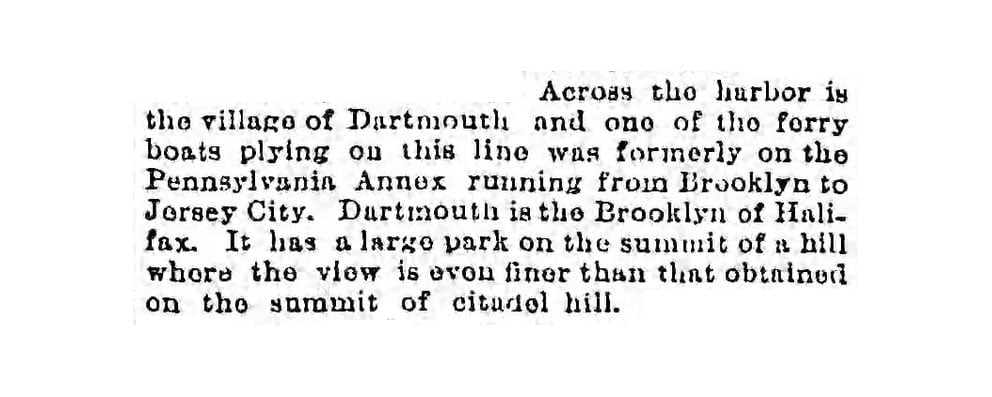
From The Story of Dartmouth, by John P. Martin:
“The struggle between the citizens and the Steamboat Company lasted about three months. In April 1890, legislation was obtained to organize the Dartmouth Ferry Commission. This body took over the liabilities of the Citizens’ Ferry Committee. Delegates were next sent to the United States to negotiate for the purchase of a secondhand ferryboat named the “Annex”. Meantime the small steamer “Arcadia” kept running in opposition to the Company, transporting people for two cents, and later for one cent. Nearly everyone boycotted the regular ferry. By midsummer the Steamboat Company felt obliged to capitulate. Then all the property of the 75-year-old Halifax and Dartmouth Steam Ferry Company was acquired by the new Dartmouth Ferry Commission. The makeshift landing and ticket booth at Campbell’s wharf were abandoned.”
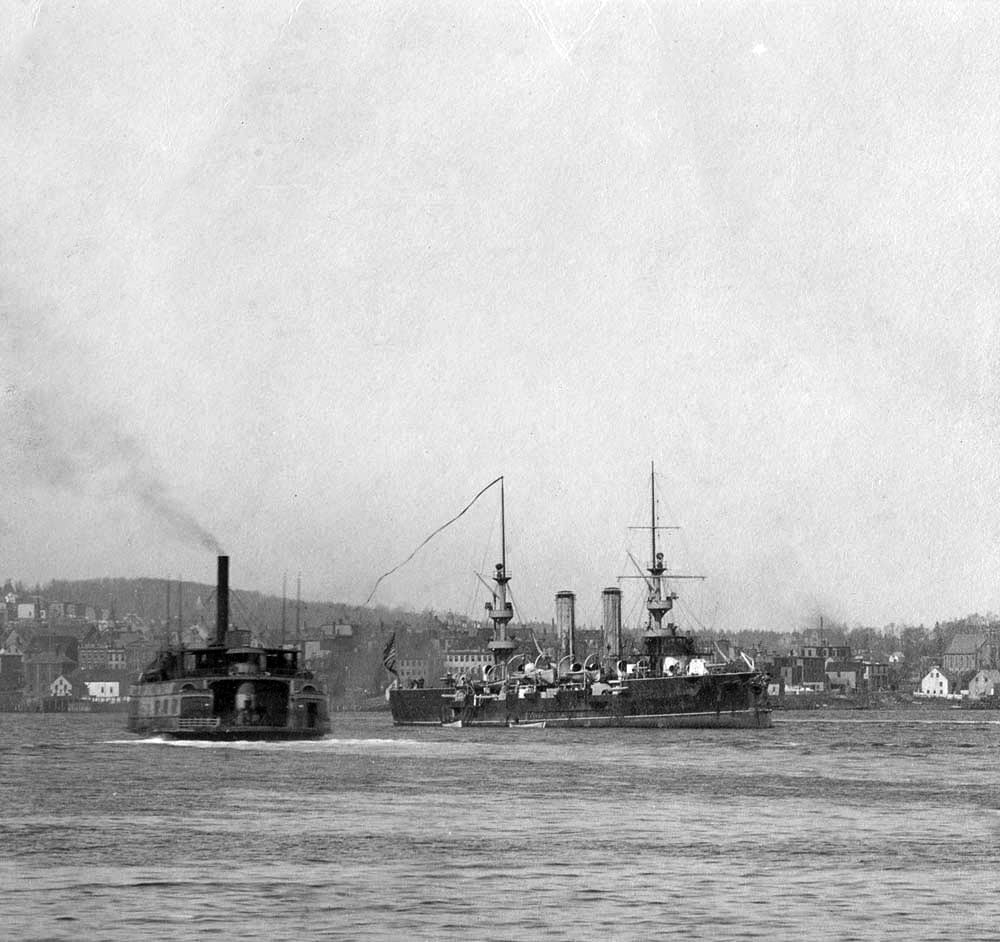
“Photograph shows the congregation of Dartmouth Lake Church (now Victoria Road United Baptist Church).
The church, also known in its early days as the African meeting house, was founded in 1844. Until 1906 the church was located at the corner of what is now Crichton Ave. and Micmac Blvd.”
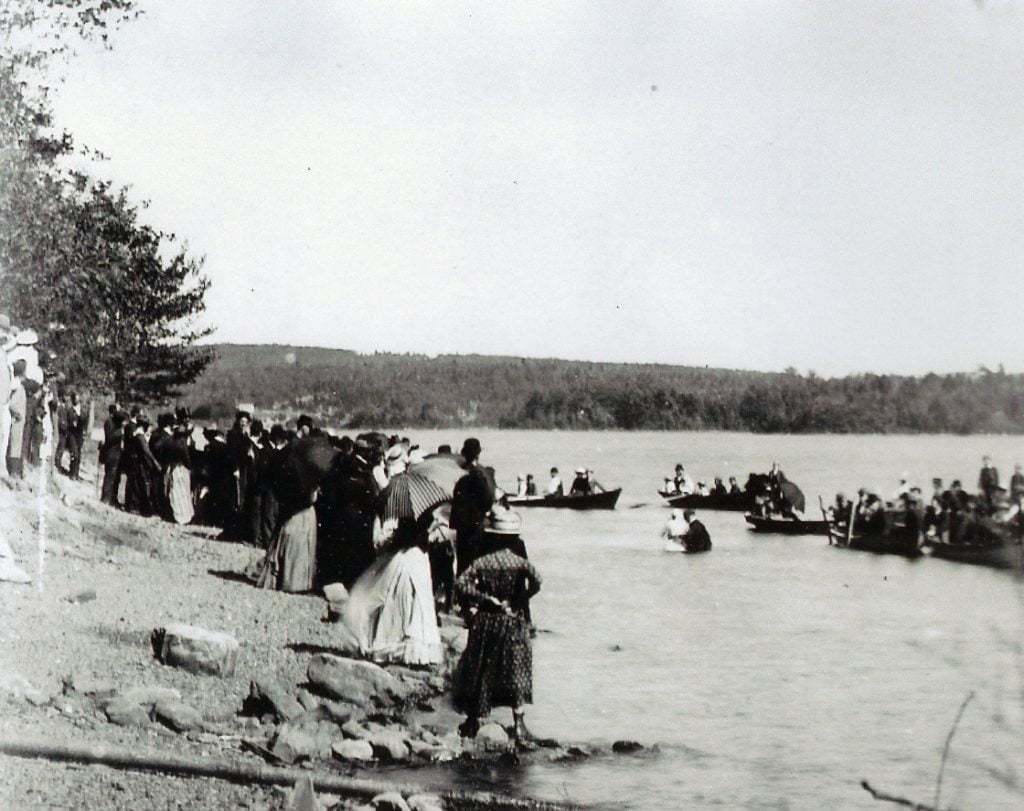
Looks to be located near Birch Cove today. (https://goo.gl/maps/dRmdoHL5mbhbWX7Z9) https://archives.novascotia.ca/Africanns/archives/?ID=149
Plaque from inside Victoria Road Baptist Church:
“In loving memory of early Black fathers who settled at Dartmouth Lake Road 1814, (now Crichton Avenue) and whose abandoned graves were exhumed August 1976, and moved to Christ Church Cemetery. Remembered include: Martha Tynes, George Tynes, Elizabeth Tynes, James Riley and Issac Smith. Dedicated December 7, 1977”
See also:

Here we see the historic plaque unveiling at Starr Manufacturing Works during Dartmouth’s Bicentennial in 1950. The man in the middle has Just performed the ceremony. He is Leander F. Stevens who has been employed at the Starr plant, almost without interruption, since 1883. At the right is Arthur C. Pettipas, Bicentennial Chairman, who delivered the address. At left is John P. Martin, Chairman of Plaque Committee. Deputy Mayor Carl Merson presided. Guests included. Rev. E. W. Forbes, nephew of John Forbes, and Alexander Patterson, veteran champion skater. Note spring skate on upper left opposite modern model. (Skate designs by H. B. Douglass, Plaque design by Peter Douglass).
A new Company re-organized in 1939, today is employing about 35 persons. Their products include bolts, nuts, rivets and all kinds of metal fastenings. They are showing steady progress under the Presidency of Gordon D. Stanfield.
From The Story of Dartmouth, by John P. Martin:
The Dominion decennial census of 1911 gave Dartmouth’s population at 5,058. In February of that year, two-roomed Victoria School was opened at the southeast corner of Wyse Road and Common Road. The new ferry-steamer “Halifax” was launched in Scotland. Daniel Brennan commenced the first automobile-bus service around Dartmouth and also ran trips to Cow Bay Beach. In a short time, he abandoned the venture. Many Dartmouthians saw their first airship flights at the Provincial Exhibition. Sir Wilfrid Laurier campaigned in Halifax for the Dominion elections. The big issue was reciprocity with the United States, and the result was a victory for the Conservative party, led by Robert L. Borden, the representative for Halifax County in the House of Commons.
More permanent sidewalks were laid in Dartmouth that year. The dates of construction are still indicated by brass figures embedded at our various street corners. Road racing continued in vogue, with Dartmouth boys making their usual creditable showing at the contests in Halifax. President Stanley MacKenzie of Dalhousie University, a former Dartmouth resident, presented the annual prizes at Greenvale School. Dartmouth firemen assisted at an all-night conflagration of the King Edward Hotel in Halifax. The Dartmouth Board of Trade took advantage of the change of Government, and renewed their requests to Ottawa for the construction of permanent bridge across the Narrows. The steam-yacht “Hirondelle” equipped with wireless telegraphy, sent out a musical program over the air, from her anchorage in Halifax harbor.
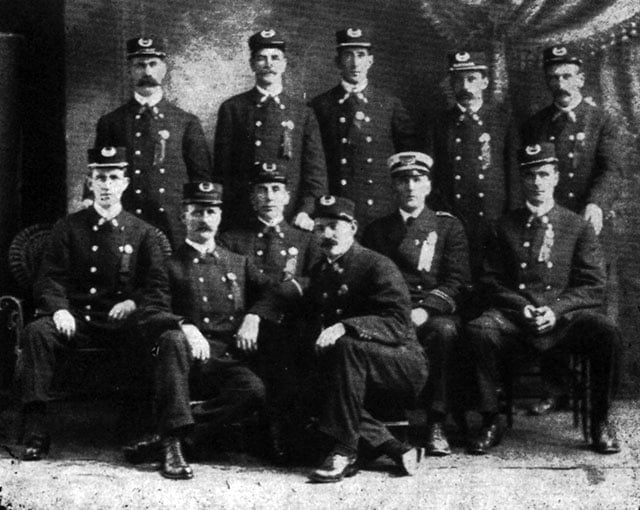
This is the Dartmouth Axe and Ladder Company running team taken during “Old Home Week.” celebrations at Yarmouth in July 1911. Out of ten teams contesting” in the hook and ladder race, the Dartmouth group were only one fifth of a second behind the winning team from New Aberdeen. Back row, left to right: Alexander (Sandy) Patterson, William Chapman, Arthur Bonang, James Baker, Richard Walsh. Front row, left to right: Douglas Patterson, Martin Murphy, Harry Young, Clarence Short, Fire Chief Trefry of Yarmouth, Arthur Emery.
From The Story of Dartmouth, by John P. Martin:
By 1909 efforts were still being made to start construction work on the Nova Scotia Eastern Railway. Rumors that the Provincial Government were considering an advance of one million dollars to promoters of the railroad, aroused strong protests from County Councilors that winter. They passed a resolution pointing out to the Government that such a financial outlay would benefit only a certain section of Halifax County, whereas if the same amount were applied to the macadamizing and widening of trunk roads, the money would be expended to much better advantage.
Speaking for the resolution, Councillor W. A. Temple of Waverley said that macadamized roads would be the forerunner of better means of communication. In the very near future, automobiles would be manufactured at a lower cost than at present, and could then serve the needs of farmers equally as well as railroads.
At the same session, County Councilors vehemently denounced the recklessness of certain auto drivers who kept speeding towards a skittish horse, already showing signs of becoming unmanageable. The number of farmer’s’ horses and wagons along a highway far outnumbered automobiles; and moreover, the former used the roads for purposes of making a living, while the autoist raced through the countryside merely for motives of pleasure.
The Councilors thereupon drew up a by-law which in effect, was somewhat the same as had been adopted in some other Counties of Nova Scotia, and in some other Provinces. It declared that:
NO AUTOMOBILE SHALL BE ALLOWED TO RUN ON ANY ROAD IN THE MUNICIPALITY OF THE COUNTY OF HALIFAX, EXCEPT ON TUESDAY AND THURSDAY IN EACH WEEK.
The penalty for infraction of the automobile bylaw was $50 for the first offence, $100 for the second and $200 for the third offence with or without imprisonment of 60 days.
The comment of the “Dartmouth Patriot” agreed that the law was drastic but the County Council felt that the highways should be preserved for the people. Some rural roads had not been improved for years, and were little better than wagon tracks around a side hill or along a river-bank where an automobile and an ordinary carriage could not pass, without one or the other being forced off the road, said the editorial.
A few months later the Dartmouth newspaper again commented:
“The vexed question of prohibiting motor vehicles from the use of the public highways is rapidly being adjusted in different places. The auto has come to stay. That might as well be understood. The only thing is to so regulate traffic that it will not interfere unduly with the great number of people who do not own these vehicles. Nearly every County in Nova Scotia has laws of its own which prohibit the traffic on certain days of each week. In Halifax County the prohibition is very severe, but so far no prosecutions have taken place although the law is violated every week. In fact the bylaw is a dead letter. In time, the auto will be as common as carriages are today, so it is better to prepare for them.“
Dartmouth made a far-reaching step towards modernity in 1909 when the Town commenced the construction of permanent sidewalks. The first stretch of concrete was laid along the east side of Water Street between Portland and Quarrell Streets. The western side of the same block was the next to be laid, and the concrete walk continued down the north side of the ferry hill to the railway tracks. Another half block was completed that autumn on the north side of Portland Street from Sterns’ corner to Prince Street.
There was a proposal to extend Prince Street through to Quarrell Street at a cost of about $6,000, but the question was defeated by an adverse vote of ratepayers at a plebiscite.
That year the Governors of Dalhousie University, who were seeking a suitable location for building expansion, came to Dartmouth and looked over the Common field as a possible site.
At Greenvale School in October, Lieutenant-Governor D. C. Fraser presented pupils with prizes won during the previous term. It was the first time that a representative of the Crown had paid an official visit to Dartmouth schools.
There was a real Jesse James hold-up with real shooting, in a lonely part of town that fall. The scene was nearly opposite the present Memorial Rink on Wyse Road, then a narrow thoroughfare bordered by a swamp of trees and bushes. Back in last century, the road had been constructed largely at the expense of the Ropeworks Company because of the more direct route it afforded their teams in the movement of raw and finished material to and from the ferry. On account of its isolated position, the road was seldom used by other vehicles, and its pedestrian traffic was mostly confined to the few factory or office workers, who lived downtown.
During the noon hour on Friday, November 5th, as accountant George Foot, with a leather-bag containing a $2,000 payroll for Ropework employees, was being driven from the ferry in an open-seated double-carriage by a veteran hackman named Lewis DeYoung, two masked men Suddenly sprang out from the bushy swale on the western side of the roadway.
One of the outlaws dashed forward to seize the horse’s bridle, while his accomplice made a leaping lunge at George Foot and tried to wrench the precious money-bag from his grasp. Both attempts failed. The startled horse violently jigged his head clear, and bounding forward, hurtled his assailant aside. At the same moment Mr. Foot’s attacker was knocked off balance by the sudden jerk of the wagon. Then a revolver went off. either accidentally or by design, but the bullet came near to being fatal for Mr. Foot in the fleeing carriage, for the deadly missile whizzed straight across his mouth inflicting a painful wound which bled profusely as the horse galloped furiously northward to safety.
The whole affair was over in a minute, according to eyewitnesses David Drury and Clifford Smith, two northend boys who happened to be on the road at the time, although some distance apart.
The gunmen jumped back into the woods, and were last seen scurrying up the slope of School Street through the Common. They must have continued past Albro’s and the other lakes to ‘the northward, then turned westerly towards the railway track because a volunteer posse from the Ropeworks were able to follow their trail. They were overtaken near Flint’s farm about three hours afterwards, and surrendered without resisting. Their names were Charles Gallagher and Herbert Hassett. Both were residents of Massachusetts, although Gallagher had been born in Dartmouth. They got eight years each in Dorchester Penitentiary.
In 1909 the Western Union Telegraph Office closed up after two years trial in Dartmouth. About this time also the operator and typist at the Consumers’ Cordage Company resigned, and the private telegraph wire there was disconnected. The last operator was Miss Isabel McKay of Pictou. The only other large establishment to have a private wire was the Sugar Refinery, but they had closed it out about ten years previously. John Toomey was the last operator. All messages were then sent by telephone.
That year Mrs. Annie Smith (formerly Mrs. William Dear of the Stag Hotel), died at Brooks’ Corner in Preston, aged 106. At Dartmouth, the well-known “Ned” Beals of Preston, after being tormented by a local gang, aimlessly smashed a plate glass window with a retaliatory missile on Portland Street.

Edward Ned Beals
From The Story of Dartmouth, by John P. Martin:
A major change in educational arrangements was made by an Act of the Legislature in 1908 when all districts outside the boundaries of Dartmouth were separated from the Town, as far as school accommodation was concerned. Ever since incorporation in 1873, Dartmouth had provided for the education of pupils living in the vicinity of Tufts’ Cove, of Cole Harbor Road and of Woodside. Residents of these places then paid school taxes to the Town, and general taxes to the County. The new Act authorized the organization of the Woodside-Tufts’ Cove School Section, having its own Board of Trustees. The County subsequently purchased from the Town of Dartmouth the two school buildings in these areas. The price paid was $7,435.
Dartmouth councilors unsuccessfully opposed this bill in the Legislature because they held out hopes of bringing Woodside into the Town in future years and because Dartmouth had then just begun to receive a substantial school tax from the Sugar refinery after a long period of exemption. It was said at the time that difficulty arose from the circumstance that Dartmouth assessors were assessing property in the County by the same yardstick as they used in the Town. The result was that Dartmouth assessment values for school rates in the County sections were nearly twice as high as the values levied by the County assessors. The sugar refinery naturally sought the cheaper governing body.
Down at the ferry, some sweeping changes were made in commutation tickets. For instance, the family ticket of $3 per month was abolished completely. It was pointed out that some families comprised ten or twelve persons who were thus crossing at a ridiculously low rate, while adult transients paid a straight five-cent fare. The rate of 67 cents per month for women, and of 84 cents per month for male minors, went up to $1.00 each. For adult males, the price remained at $1.50. The rate of 34 cents a month for domestic servants, a relic of the past, was also abolished. In that year, Charles A. Hunter succeeded Henry Watt as Ferry Superintendent. He had been on the boats some 10 years.
One of Captain Hunter’s first assignments was the transporting of nearly 8,000 passengers who crossed over on the boats for the Natal Day celebrations on July 30th. Many came in the morning to witness the finish of the first modified Marathon race from Halifax to Dartmouth via Bedford and Burnside. Hans Holmer won.
Enthusiasm for boat racing was at its height during the rowing season of 1908, for it was the year of the Olympic games. The 4-oared shell crews of St. Mary’s, North West Arm and North Star Clubs held contests in June, and finished so closely together every time, that all three were sent to the Canadian trials in St. Catherine’s, Ontario. At that place, the final winners were the Argonaut four of Toronto.
At Dartmouth on Natal Day, the North Stars easily capture the senior shell contest. At the Lorne Club regatta they broke a oar, and were out of the race. At Springfield Mass., on August 14th St. Mary’s crew won the straightaway championship of America On August 22nd, the North Stars defeated St. Mary’s and three other crews at the Arm regatta. Finally on Labor Day, the North Stars again won the Maritime Championship, and set a new record of nine minutes for the 1 ½ mile course. One length behind then came the second North Star entry of Curren brothers, Faulkner and Keddy. St. Mary’s, Lornes and Arm crews followed in order.
On summer evenings an amateur baseball league attracted crowds to the Chebucto Grounds, which was then unfenced. I: autumn there would be four or five tug-of-war tournaments held in the wooden rink. Athletic organizations then active in Dartmouth included the D.B.C.A., Banooks, Centrals, North Stars, St. Peter’s, Mount Amelias, Dartmouth Harriers, and Woodside Club.
Supervisor of Schools Ernest W. Robinson terminated his Dartmouth engagement in June, and was succeeded by William C Stapleton. Like his predecessors he taught the Grade IX class until one o’clock. After dinner he had numerous other duties.
During the year 1908, the water and sewerage system to the north-end was practically completed. A new stone-crusher operated by water-power was set up on the Walker property, just north of Findlay’s Pond on the location of the present Tourist Bureau. A granite curb and the first piece of concrete sidewalk were laid a’ Sterns’ corner. In the matter of health, there was another mild smallpox scare when some 40 slight cases were quarantined. In addition, about 28 houses were placarded for diphtheria.
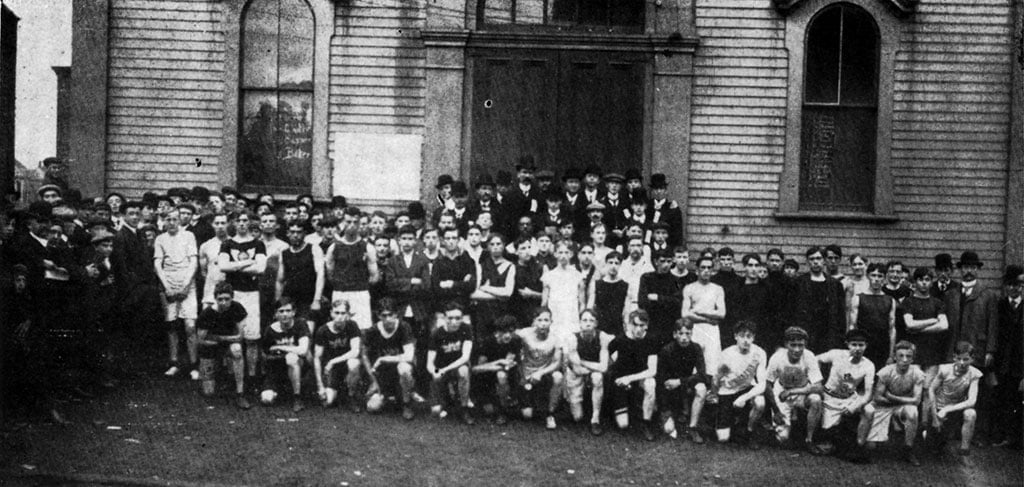
Here are 60 Halifax and Dartmouth runners at the DBCA Hall ready for the Williams Cup race around Woodlawn on Thanksgiving Day 1908. The tall man with the beaver hat at the door, is Mayor Notting. On his right is Stephen Myatt, and then James Tobin. Left of the Mayor are G.P. Monohan, H.R. Walker, H.W. Hewitt, Ross Day. A hand is on Harry Young’s shoulder. Down from him is Aldred Rodgers dressed in white, and with arms folded. He won the race. At Rodger’s right is James Martin, then A.C Pettipas, then the third next runner wearing sash is Harry Smith. At Rodgers’ left is J.J. Myatt, then Albert Downey who was second. D.R. Patterson is kneeling second from left. James Renner in bowler hat, is at extreme left. Crowds of spectators were lined along Ochterloney Street.